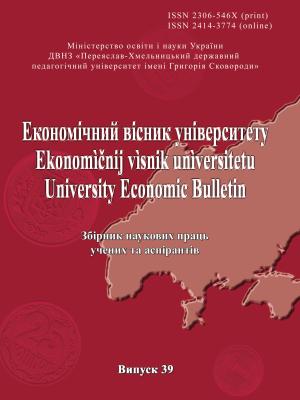Тінізація української економіки як негативний фактор її розвитку
Shadow economy growth in Ukraine as a negative factor of its development
Author(s): Iryna LukianenkoSubject(s): National Economy, Economic policy, Security and defense, Criminology, Economic development
Published by: Університет Григорія Сковороди в Переяславі
Keywords: shadow sector; economic growth; shadow economy reducing; modeling; panel data models; scenario analysis;
Summary/Abstract: The subject of the study is a set of theoretical and methodological foundations, as well as econometric tools for substantiating the representation of the shadow economy as a negative factor for the development of the Ukrainian economy. The purpose of the study is to empirically analyze the peculiarities of the impact of the main factors and risks on the level of the shadow sector in Ukraine and other countries in the world, as well as to determine the strategic directions for further reducing of shadow part of Ukrainian economy with the use of the developed econometric toolkit. Such general scientific methods of analysis and synthesis as methods of comparative analysis, generalization, systematization, and grouping of data, methods of graphic and scenario analysis, as well as econometric tools, in particular methods and models of panel (longitudinal) data wereused in the process of research. Results. A significant amount of the shadow sector in Ukraine poses additional threats to the effective functioning of the economy and its economic development, especially in conditions of political and economic instability. The conducted statistical and empirical analysis confirmed the hypothesis that during a deep economic crisis, the shadow economy may not only be a consequence but also a cause of a growing fall in gross domestic product and, in turn, can aggravate a crisis that is also characteristic of the Ukrainian economy. Even though in recent years there has been a tendency of reducing the shadow level of the Ukrainian economy, it is still a considerable amount, which threatens the financial and economic security of the state and requires the formation of a scientifically grounded strategy for its lowering. The current situation requires not only an adequate definition of the sources of the shadow economy, mechanisms and development, the relationship with the formal economy but also the definition of the main factors affecting its level, as well as quantitative assessment of such impact using economic and mathematical methods of research. The empirical analysis of the impact of the main financial and economic indicators on the level of the shadow economy on the basis of panel data tools for a sample of more than 31 countries of the world allowed to identify not only the main macroeconomic factors affecting the shadow economy, taking into account the specifics of each individual state, but also significantly increase the number of observations and thus increase the accuracy of calculations in the conditions of limited information in a time dimension. Besides, the presentation of countries of different groups in the sample allows, for example, to measure how the country's entry into the European Union affects the level of the shadow economy and whether it affects it overall. According to the modeling results, the clustering of the countries was carried out depending on the level of the shadow sector and the initial conditions for the tendency to shadow. The hypothesis is that the shadow economy of Ukraine exists and even develops in favorable terms that are accompanied by low rates of social and economic development, the imperfection of the legislative and the judicial system, the complexity of opening and doing business, a rather high level of tax rates and a significant spread of corruption. Moreover, a scenario analysis based on the developed model showed that, in the wake of the economic crisis, the shadow economy of Ukraine would tend to increase, which will further deepen the economic downturn in the country in the medium term. Accordingly, the definition of strategic directions for lowering the part of the shadow economy in Ukraine becomes one of the priority tasks of its economic policy. The results of the study can be used by public authorities to form economic policies and strategic directions aimed at ensuring a gradual reduction of the shadow economy in Ukraine, enhancing its financial security and economic development. Conclusions. The presence of the shadow sector is characteristic for almost all countries in the world, but under current conditions of economic development, a significant part of shadow economy becomes an obstacle to the development of a robust corporate sector, the establishment of a functioning market economy and economic growth. The statistical and empirical comparative analysis of the factors influencing the level of shadowing of the economy of different countries confirms the fact that due to imperfect economic, social and legal reforms, many of them still have a high level of the shadow economy, including Ukraine, which negatively affects the level of its economic development. Moreover, according to the optimistic scenario based on the developed econometric model of panel data, the positive dynamics of the gradual reduction of the level of shadow economy to 30.2% of the country's GDP in 2022 were obtained. Despite that fact, according to more realistic assumptions, the growth of the shadow sector is somewhat probable to the level that far exceeds its current value. Accordingly, the definition of strategic directions for further reducing of shadow part of the Ukrainian economy is one of the critical tasks of its economic policy. At the same time, as statistical and empirical studies have shown, the effectiveness of the policy of deterrence should increase as a result of the implementation of elaborate measures aimed, in particular, at reducing the impact of factors that increase the level of the shadow economy in the country; increase of expenses from attraction to shadow activity and riskiness for its participants; raising public awareness about the harmful effects of shadow economy; growth of personal income and living standards of the population, etc.
Journal: Економічний вісник університету
- Issue Year: 2018
- Issue No: 39
- Page Range: 101-113
- Page Count: 13
- Language: Ukrainian

